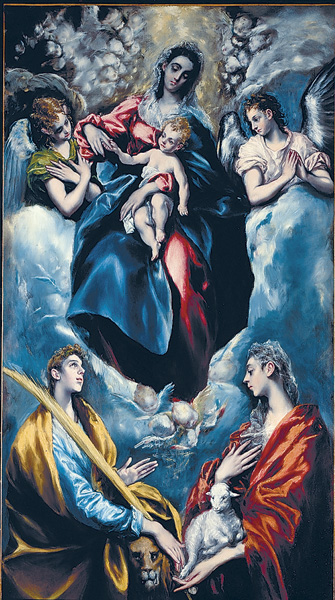Thecla: The Apostle Who Defied Women’s Destiny
025
Who was Thecla? Little known today, especially in Protestant churches, Thecla of Iconium enjoyed fame perhaps second only to Mary, mother of Jesus, in the early Christian era.
Thecla’s anonymity is all the more remarkable because women were so prominent in the formation of the church. The Gospels mention women who accompanied Jesus and the 12 apostles from town to town and supported them financially—Joanna, Mary Magdala, Susanna “and many others” (Luke 8:3). We know that Jesus considered himself “at home” in the home of Mary and her sister Martha (Luke 10:38–41; John 11:1–3, 12:2). After Jesus’ death, women evidently traveled as missionaries with their husbands or brothers (Romans 16:3, 7, 15); in Romans 16:7, Paul calls Junia an apostle, and he greets Euodia and Syntyche as “coworkers” (Philippians 4:2–3)—a term (in Greek, sunergos) that he usually reserved for apostles. Paul also makes it clear that women were expected to “prophesy” in the churches (1 Corinthians 11:5–10).
The voices that have come down to us from the early church are, however, those of men. Modern historians of the church study the Apostolic Fathers, the Ante-Nicene 026Fathers, and other materials written by men and about men. In other words, nearly everything we know about the early development of the church comes from the early church fathers. Men tend to be the heroes of these extrabiblical histories, and thus they have been assigned the roles of the major actors in the drama of early Christianity.
One outstanding exception is depicted in an apocryphal book written as early as the late second century C.E. and known as the Acts of Paul.1 She was Thecla, a woman of great renown and a follower of the apostle Paul. Thecla defied social convention of her time to follow the apostolic path herself. In the succeeding centuries, her fame extended from Asia Minor to the eastern borders of the church, to the sands of Egypt and into Europe. She was celebrated not only in oral and written legends but also at sacred sites where she was venerated and in art. Thecla’s story provides valuable insights into the role of women in early Christianity, as well as the challenges a female apostle faced in the Greco-Roman world.
Thecla’s tale is so different from the rest of the Acts of Paul that scholars conclude that it almost certainly circulated separately, probably in oral form, during the second century or perhaps even earlier, and was only later combined with the other stories about Paul.2 So there is considerable justification for referring to the Thecla cycle—sections 1–43 of the Acts of Paul—as the Acts of Thecla.
The Acts of Thecla begins in Thecla’s hometown, Iconium (modern Konya, about 150 miles south of Ankara, Turkey), when Paul arrives there from Antioch in flight from persecution. In the house of a local Christian man, Onesiphorus, the apostle preaches a message about “sexual abstinence and the resurrection”: “Blessed are those who keep the flesh pure, because they shall see God … Blessed are those who have wives as not having them for they shall be heirs to God … Blessed are the bodies of the virgins, because they shall be pleasing to God.”
Thecla, herself an unmarried virgin, sits at her window raptly listening to Paul’s preaching on her blessed state and is entranced: “When she saw many women and virgins going in to Paul, she also had an eager desire to be deemed worthy to stand in Paul’s presence and hear the word of Christ.” Her mother, Theocleia, is greatly troubled by this: Thecla is betrothed to a young man named Thamyris, yet Paul’s preaching is clearly giving her other ideas about what she wants to do with her life. Theocleia sends for her would-be son-in-law to tell him he might well lose Thecla:
I have a strange story to tell you, Thamyris. For three days and three nights Thecla does not rise from the window either to eat or to drink; but looking earnestly as if upon some pleasant sight she is devoted to a foreigner teaching deceitful and artful discourses … Thamyris, this man will overturn the city … and your Thecla too.
The “natural” destiny of a woman—dutifully to marry and bear children—is being diverted before her family’s eyes. Thecla’s whole household weeps bitterly: “Thamyris for the loss of his wife, Theocleia for that of a child, and the maidservants for that of a mistress.”
So Thamyris joins a plot against Paul and gets the apostle thrown in prison.
Thecla searches throughout the city for Paul; when she finds him, she bribes his jailers with her jewelry to let her in so she can sit at his feet and hear his words. She accompanies Paul to his tribunal, where the crowd shouts, “He is a sorcerer. Away with him!”
The governor, however, is won over by Paul’s preaching. The governor then turns to Thecla and asks why she won’t marry her fiancé “according to the law of the Iconians.” Thecla, her eyes fixed on Paul, does not answer. So her mother cries out: “Burn the lawless one; burn the non-bride in the theater so that all the women taught by this man [Paul] may be afraid.” Paul is whipped and exiled, and Thecla is condemned to be executed; she is captured as she wanders around the city “like a lamb in the wilderness [seeking Paul] as for a shepherd.”
And the boys and girls brought wood and straw in order that Thecla might be burned. And when she came in naked the governor wept and admired the power that was in her. And the executioners arranged the wood and told her to go up on the pile. And having made the sign of the cross she went up on the pile. And they lighted the fire. And though a great fire was blazing it did not touch her. For God, having compassion upon her, made an underground rumbling, and a cloud full of water and hail overshadowed the theatre from above, and all its contents were poured out so that many were in the danger of death. And the fire was put out and Thecla saved.
Thecla goes off again in search of Paul. When she finds him she offers to cut her hair like a boy so that she 027may follow him, but the apostle is strangely reluctant to accept her conversion and puts off baptizing her:
“Times are evil and you are beautiful. I am afraid lest another temptation come upon you worse than the first and that you do not withstand it but become mad after men.” And Thecla said, “Only give me the seal in Christ, and no temptation shall touch me.” And Paul said, “Thecla, be patient; you shall receive the water [baptism].”
At this, the midpoint in the story, Thecla has cut herself off from her destiny as a “normal” woman in Greco-Roman society. But Paul has still not granted her a role in the church. She is adrift.

In part two of the story (Acts of Paul 26–43), Thecla and Paul enter Antioch, and Alexander, a leader of the city, becomes enamored of Thecla. Assuming she belongs 028to Paul, Alexander gives the apostle money and gifts, hoping Paul will give Thecla to him. Paul claims that he “does not know the woman or have any claim on her.” Alexander then attacks Thecla and apparently tries to rape her. An ancient reader (or listener) would quickly understand the implication of the text: A woman traveling alone is “asking for it.” But Thecla fights back, tears Alexander’s clothes and knocks off his crown, publicly humiliating him. In retaliation, Alexander drags her before the local governor, who “condemned her to the wild beasts.”
At this point, the conflict between male and female assumes cosmic proportions. A high-born woman, Tryphaena—also described as a “queen” and a relative of Caesar—takes Thecla in as a daughter, to keep Thecla “pure” until she must fight the beasts. The women of the city shout that Thecla’s sentence is an “evil judgment! impious judgment!” When her time comes, she is tied onto the back of a lioness and sent into the arena, where the fierce animal commences to lick Thecla’s feet, to the astonishment of the crowd. The lioness defends Thecla from a bear and then dies defending Thecla from a lion.
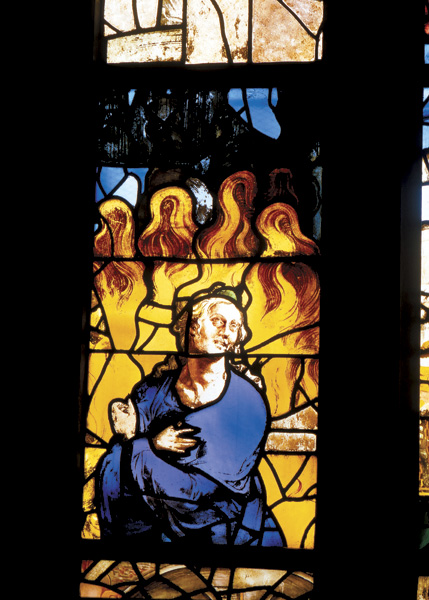
More beasts enter as Thecla stands and stretches forth her hands in prayer. When she finishes, she turns and sees a large pit full of water. “Now it is time to wash myself,” she says, and throws herself in, announcing: “In the name of Jesus Christ I baptize myself on my last day.”
The pool happens to be full of man-eating seals, however, and the crowd begs her not to throw herself in. But a lightning bolt strikes the pool just then, electrocuting the seals and leaving Thecla unharmed.
“Other and fiercer animals” are now let loose against Thecla, but the women lamenting the judgment against her come to Thecla’s aid by throwing flowers and perfume into the arena—a form of benign and feminine chemical warfare that hypnotizes the wild beasts so they refrain from attacking her.
The villainous Alexander is persistent. He tells the governor he has bulls with which to draw and quarter the intransigent woman. This plan too is thwarted when a heavenly fire burns the ropes tying Thecla to the bulls. The governor then puts a stop to the proceedings, and Alexander begs for mercy; the whole city is in dismay because Queen Tryphaena has fainted from the violence and is thought dead. Everyone fears the wrath of Caesar.
Thecla, saved, converts Tryphaena’s household to Christianity, and the queen, now revived, outfits Thecla and sends her to resume her travels—this time to Myra, to find Paul. There, Paul finally recognizes Thecla’s power and commitment and gives her an apostolic commission: “Go and teach the Word of God.”
Thecla has now completed her transformation; she has gone from a typical Greco-Roman female—disempowered, trapped at home—to a woman wandering 029with no defined role to, finally, a teacher and an apostle with real power.
She returns to Antioch, where Queen Tryphaena gives her enough wealth to make her independent. Thecla clothes herself as a man (a necessary move to allow her to travel safely in the Roman Empire) and goes to Iconium to see her mother: “Theocleia my mother, cannot you now believe that the Lord lives in heaven? For if you need money, the Lord will give it to you through me; recognize your child; I stand before you.” Theocleia, however, remains silent.
“When she had given this witness [Thecla] went away to Seleucia; and after enlightening many with the Word of God, she slept with a noble sleep.”
Later manuscripts, addenda to the Acts of Thecla, give us more legends about Thecla’s ministry. In one, Thecla is so successful at healing that the physicians in Seleucia become angered at their loss of business and stir up some drunken thugs, sending them to attack Thecla “like lions.” She escapes by disappearing into a cleft in a rock, not to be seen again other than in visions.
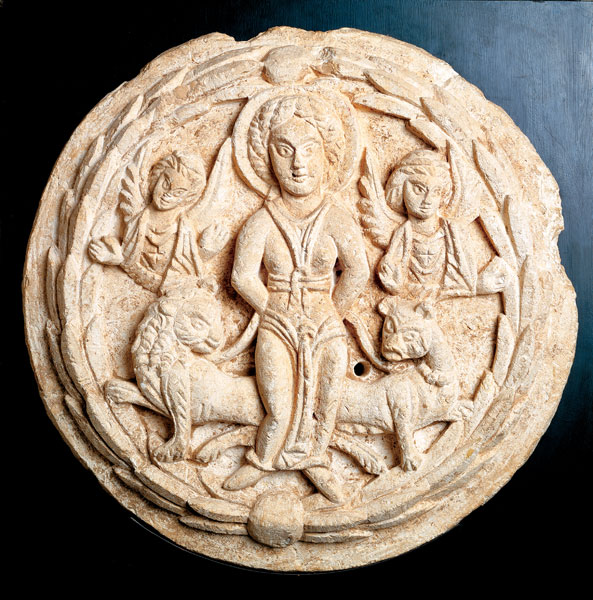
Thecla’s story is basically a narrative commentary on Paul’s pronouncement at the beginning of the tale, when he is preaching and Thecla is listening from the window: “Blessed are those who on account of the love of God have left the structures of this world.” It is about the spiritual odyssey of a woman who passed from paganism to Christian leadership—that is, to preach and to baptize—in defiance of the social expectations of Greco-Roman society. Thecla’s “liberation” at Antioch from the expected social roles assigned to her in Iconium threatens the accepted places of male and female in the cosmos. At the climax of both parts of her narrative, she cuts her hair and she puts on male clothes. The story seems to indicate that Thecla must assume a kind of “maleness” in order to be free to preach, teach and heal.
Certainly practical reasons may account for a female preacher’s wanting to assume male appearance: Traveling alone or with someone other than the man (husband, father or master) to whom she belonged was dangerous for a woman.
But Thecla’s assumption of a male appearance also had an important religious and social message. In the Greco-Roman world, the primary human form was thought to be male. Such an understanding is not easily cast away—even in the church, as many 20th-century women can attest. As Stephen Davis, professor of New Testament at the Evangelical Theological Seminary in Cairo, Egypt, puts it: “In the context of an ancient society that held fast to misogynistic assumptions about women’s weakness, the act of dressing ‘like a man’ would have signified a radical break from customary assumptions about women’s identity in society.”3 The Acts of Thecla points to at least a significant group of women in the early church who took seriously what 031Paul says in Galatians 3:28: “In Christ … there is no male and female.”
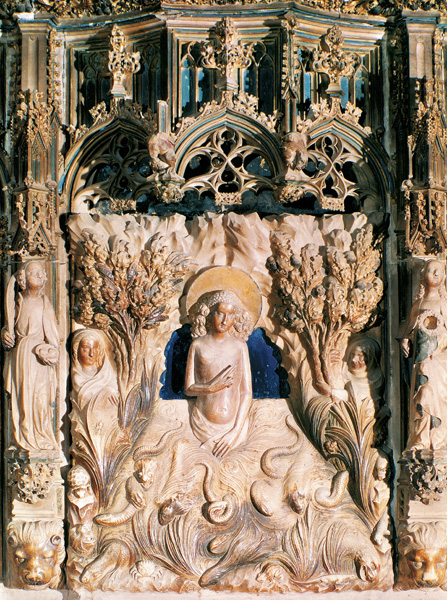
Despite the Greco-Roman world’s prevailing social attitudes about men’s and women’s proper spheres, it is becoming more and more accepted among historians that female apostles like Thecla did exist in the church. A rapidly emerging example is Mary Magdalene. In spite of the bad rap (that she was a prostitute, rescued by Jesus) given her by the later church, certain early Christian apocryphal texts (the Gospel of Mary, the Dialogue of the Savior and the Gospel of Philip) indicate that Mary was a special insider among the apostles.a An early church father, Hippolytus (died about 236 C.E.), names her as “apostle to the apostles” in his Commentary on Song of Songs. But how many female apostles ministered in the church? And how were they received by that mostly male-dominated institution?
Male authors of the early church tended to dismiss women’s voices. The city’s public discourse was the province of men; the voices and stories of women tended to circulate and be heard mostly in the home. The phrase “old wives’ tales” is not a modern conceit; in 1 Timothy 4:7, we read: “Have nothing to do with profane myths and old wives’ tales.” Later the same author inveighs against young widows who “learn to be idle, gadding about from house to house; and they are not merely idle, but also gossips and busybodies, saying what they should not say” (1 Timothy 5:13). The legends about Thecla likely originated as oral stories shared by women in this way. The Acts of Thecla stars Thecla, and Paul takes the main stage in the remainder of the Acts. There is nothing in the rest of the Acts of Paul remotely like the episodes in the Acts of Thecla, where women prevail over the almost universally antagonistic males; even Paul strongly borders on the role of an opponent to Thecla in the Acts of Thecla. These elements, plus the oral nature of the Thecla tales, seem to point to the female origin of her story.
Dennis MacDonald of the Claremont School of Theology has argued persuasively that the Acts of Thecla stems from women’s storytelling but also that the so-called pastoral epistles—1 and 2 Timothy and Titus, which are attributed to Paul but are generally taken to have been composed by someone else, perhaps a group of Paul’s followers—were written precisely to counter the influence of such figures as Thecla.4 The thrust of Paul’s sermon in the opening sections of the Acts of Thecla displays the same attitude toward women that we find in the genuine letters of Paul (e.g., Galatians 3:28; 1 Corinthians 7:4, 11:5–12; Romans 16), but it is the kind of message the pastoral epistles appear to speak against—for instance 1 Timothy 2:15: “Salvation for the woman will be in the bearing of children” (see also 1 Timothy 4:1–6, 11–15; 2 Timothy 2:6–7; Titus 3–5).5 The attitude of the pastoral epistles—that women should seek salvation by fulfilling their traditional role in the home—stands counter to Paul’s assumption in 1 Corinthians 11:5–12 that women are expected to “prophesy” (that is, preach) in the church.
The second-century writer Tertullian of Carthage shared the view of whoever wrote the pastoral epistles. He specifically criticized the Acts of Paul because they “defend the right of women to preach and to baptize”—therefore they must have been “falsely written” by an “elder in Asia Minor” (About Baptism 17). He is clearly referring here to the Thecla story. It is the earliest mention of these tales and the reason we know they were already added to the Acts of Paul by the end of the second century (when Tertullian wrote).
Yet there were also other forces in the early church and into the early Middle Ages that took a much more accepting view of women like Thecla. Among those who gave great prominence to Thecla were major church figures like Ambrose, Gregory of Nyssa, Gregory of Nazianzus and Athanasius. As the early eighth-century writer John of Damascus put it, Thecla is “the proto-martyr and equal of the apostles.” The church came to regard Thecla as the first female martyr.
Whatever the church fathers thought, Thecla seems to have been a very popular figure with the wider Christian public. In the latter part of the fourth century, Egeria, a pilgrim woman from Spain who kept a diary of her travels to Palestine, Mt. Sinai and Asia Minor, made a trip to Seleucia (now the modern Turkish town of Silifre) where she visited a shrine-complex dedicated to Thecla. Egeria describes the shrine as a busy place, fortified (walled) against invasions by the “Isaurians” (probably brigands and bands of thieves). Archaeological excavations here have shown that Hagia Thekla (St. Thecla) was a very large complex and no doubt as influential as Egeria describes it. The grotto church had a nave almost as long as a football field. There were also other, smaller chapels, rooms for pilgrims and cells for male and female monks. Services, as Egeria describes them, included readings from a collection of Thecla’s acts and from accounts of her miracles. These miracles included intercession for pilgrims 032in danger (especially women), for healings and for the strengthening of faith.6
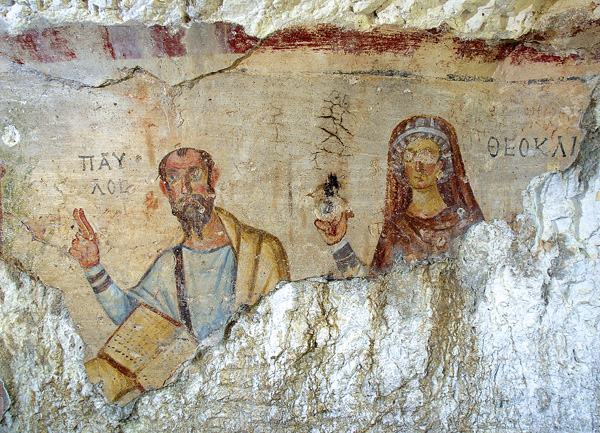
Near Ephesus, on the Aegean coast of Turkey, an ancient grotto is dedicated to St. Paul, dating to the early fourth century. Although the cave had been excavated as early as 1906, in 1998 some frescoes on the walls were cleaned, revealing what must originally have been a scene of Thecla listening to Paul’s preaching in Iconium. Still visible are Paul and Theocleia (Thecla’s mother), both labeled (see photo).7
Thecla’s fame was widespread even in Egypt, probably centered in Alexandria. The famous early fourth-century bishop of Alexandria, Athanasius, cited her as the most important model for women’s ascetic piety.8 Other important centers for veneration of the martyr also existed in Egypt; Thecla images were found, for example, at a Christian necropolis at the Kharga oasis of El Bagawat. Many pilgrim souvenirs called eulogiai,b in the form of small flasks, bear the image of Thecla; even houseware from North Africa is decorated with images of her martyrdom. From the fourth century, pieces of pottery, lamps and plates of African Red Slip Ware, probably made in northern Africa, show Thecla battling the beasts, often with an inscription: domina victoria—“Lady, the victory is yours.”9
In modern times, for example in northern Italy, Thecla remains one of the most popular saints and martyrs. The painter Tiepolo, in about 1750, created an altarpiece for the town of Este that shows St. Thecla saving the city from a plague.10 In Spain, the area around Barcelona remains important to the memory of Thecla. At Tarragona a church is dedicated to her. The structure is decorated with both Romanesque and more modern depictions of the saint and her story, including a relief showing her self-baptism in a pool of wriggling creatures (here interpreted as serpents—see photo). And El Greco’s “Virgin with St. Agnes and St. Thecla” (c. 1600; see photo and detail) hangs in the National Gallery in Washington, D.C.11
But the most intriguing and puzzling Thecla image is surely the one that also happens to be the earliest. As with many other Thecla images, this plaque (see photo) from a third- or early fourth-century C.E. sarcophagus or gravestone and now in Rome’s Capitoline Museum, celebrates the martyr’s connection with Paul: It shows a figure labeled “Paul” at the 033stern of a ship labeled “Thecla.” With one hand on the tiller and the other on the sail, Paul can be seen as steering Thecla, guiding her course. Yet the scene also bears another possible interpretation: Thecla is “carrying” Paul—that is, helping spread his words and teaching. The latter interpretation fits with the end of her story, when she goes forth to preach Paul’s messages—on virginity, on leaving the structures of this world and on the idea that “there is no male and female” in the church.12
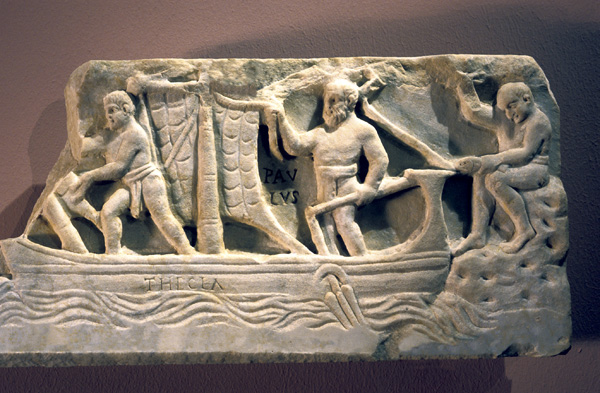
Is Thecla bearing Paul or is Paul guiding the “good ship Thecla”? In contemporary scholarly conferences where this image is discussed, both views are strongly held and the debate tends to divide along gender lines—to the amusement of all. Unfortunately, there is no way to know what a viewer from the period would have thought; perhaps it would have seemed as ambiguous in the third century as it does today.
Who was Thecla? Little known today, especially in Protestant churches, Thecla of Iconium enjoyed fame perhaps second only to Mary, mother of Jesus, in the early Christian era. Thecla’s anonymity is all the more remarkable because women were so prominent in the formation of the church. The Gospels mention women who accompanied Jesus and the 12 apostles from town to town and supported them financially—Joanna, Mary Magdala, Susanna “and many others” (Luke 8:3). We know that Jesus considered himself “at home” in the home of Mary and her sister Martha (Luke 10:38–41; John 11:1–3, 12:2). After Jesus’ death, women […]
You have already read your free article for this month. Please join the BAS Library or become an All Access member of BAS to gain full access to this article and so much more.
Already a library member? Log in here.
Institution user? Log in with your IP address or Username
Footnotes
See Jane Schaberg, “How Mary Magdalene Became a Whore,” BR, October 1992.
See the following articles in Biblical Archaeology Review: Gary Vikan, “Don’t Leave Home Without Them: Pilgrim Eulogiai Ensure a Safe Trip,” July/August 1997; and Hershel Shanks, “Solomon’s Blessings,” September/October 2001.
Endnotes
The Acts of Paul is available in several English translations, including J. Keith Elliott, The Apocryphal New Testament (Oxford: Clarendon Press, 1993), pp. 350ff (this is a total reworking of M.R. James, The Apocryphal New Testament [Oxford: Clarendon Press, 1963]); and Wilhelm Schneemelcher, New Testament Apocrypha, vol. 2 (Louisville, KY: Westminster/John Knox Press, 1992), pp. 213ff.
For more on this, see Dennis R. MacDonald, The Legend and the Apostle: The Battle for Paul in Story and Canon (Philadelphia: Westminster Press, 1983); Stephen J. Davis, The Cult of St. Thecla: A Tradition of Women’s Piety in Late Antiquity (Oxford: Oxford Univ. Press, 2001).
Renate Pillinger, “Neue Entdeckungen in der sogennanten Paulusgrotte von Ephesus,” Mitteilungen zur christlichen Archaeologie 6 (2000), pp. 16–29.
Annewies van den Hoek and John J. Herrmann, Jr., “Thecla the Beast Fighter: A Female Emblem of Deliverance in Early Christian Popular Art,” The Studia Philonica Annual: Studies in Hellenistic Judaism, 13 (2001), pp. 212–249; see also Herrmann and van den Hoek, Light from the Age of Augustine (Cambridge, MA: Harvard Divinity School, 2002), pl. 49.
The Metropolitan Museum of Art, Rogers Fund, 1937.37.165.2. The museum’s identification of the figure in the lower left has wandered back and forth between St. Thecla and St. Martina. To this viewer, the former is more likely.
A searchable database of art of the early church up through the 11th century reveals close to 200 images of Thecla; new entries are added to the database regularly. See www.maryvillecollege.edu/cartlidge/homepage.htm. See also David R. Cartlidge and J. Keith Elliott, Art and the Christian Apocrypha (London and New York: Routledge, 2001), pp. 148–162.


